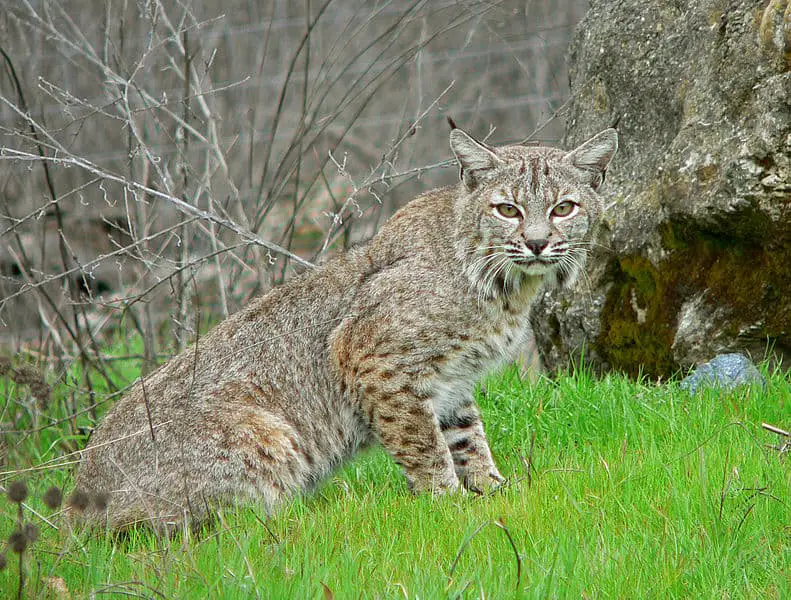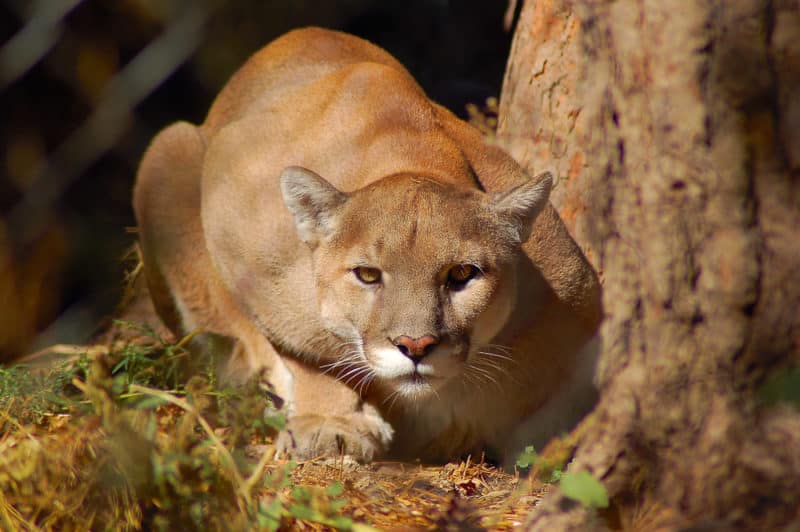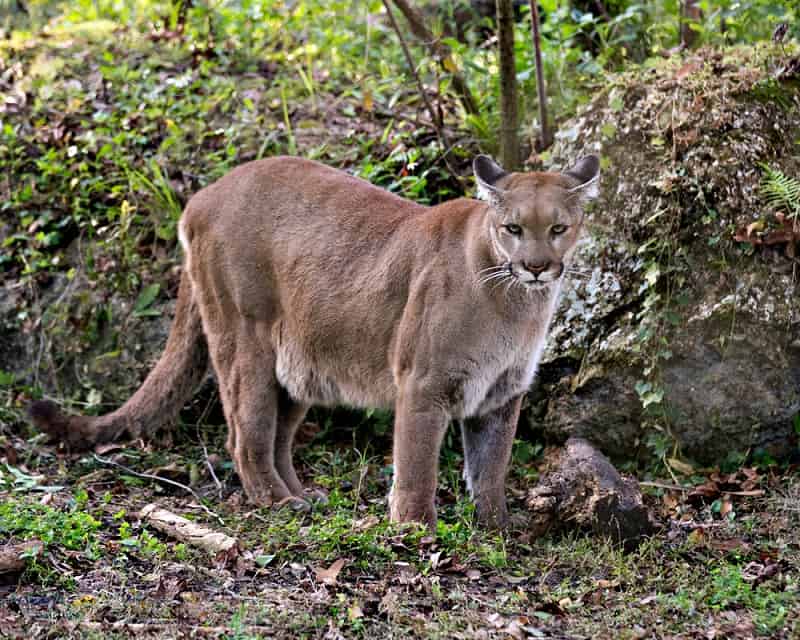The one species of wild cat living in the state of Mississippi is the bobcat. Bobcats are common throughout most habitats in Mississippi but are most prevalent in thickly wooded areas and pine plantations adjacent to farmland.
Mountain lions are also native to the state. Although people report mountain lion sightings in Mississippi occasionally, none of these sightings have ever been confirmed. There hasn’t been a breeding population of these large cats in Mississippi in over 100 years. In fact, the only known breeding mountain lion population east of the Mississippi River resides in southern Florida.
One more big cat that may or may not exist in Mississippi is the black panther. Despite the fact that the professionals at the Mississippi Department of Wildlife Fisheries and Parks insist that no such animal exists in the state, several people report black panther sightings each year. We’ll talk about that at the bottom of this article.
Bobcats in Mississippi (Lynx rufus)
Bobcats are exclusively North American wild cats and are also the most common wild cat species in North America.
Aside from feral cats, they are the only wild feline predator with a breeding population in the state of Mississippi.
Some other names for the bobcat are bay lynx, red lynx, and swamp devil.
Biologists believe that both the bobcat and the Canada lynx are descendants of the Eurasian lynx, and their ancestors crossed into North America via the Bearing Sea land bridge.
Where do bobcats live?
These small wild cats live in three North American countries. Their range begins in southern Canada and then extends south through most of the United States and down into central Mexico.
Compared to Canadian lynx, which thrive in deep snow country, bobcats struggle more in the snow due to the fact that they cannot walk on top of it like lynx can. A lynx’s huge paws function like snowshoes keeping it on the snow’s surface. On the other hand, compared to lynxes, bobcats have small feet that tend to sink into the snow. Bobcat tracks are about half as wide as lynx tracks. If the snow is too deep and powdery, it reduces their mobility along with their ability to catch prey. This is why the bobcat range dies out in southern Canada. From there on north, Canada lynx are more prevalent and bobcats less so.
These cats are mostly crepuscular or nocturnal animals, but it’s not uncommon to see one out and about in the daytime because they only sleep for 2 to 3 hours at a time.
Bobcats are solitary animals with the exceptions of during mating season or when a female is raising young. They are territorial and live in home ranges that they patrol and scent mark with urine and feces.
The size of bobcat home ranges varies with the geography and the availability of food items. However, in central Mississippi, the size of a male bobcat’s home range is around 12.7 square miles, while an average female bobcat’s home range is around 4.9 square miles. In the southeast, their home ranges are approximately 65% smaller. See
One more thing about home ranges is that adult males and adult females sometimes have overlapping ranges.

What do bobcats look like?
Adult bobcats are about twice the size of domestic cats. A domestic cat has a longer tail than a bobcat, though. Bobcats are 2 to 4 feet long with proportionately long legs.
Male Mississippi bobcats are roughly 39 inches in length and weigh 20 to 30 pounds. On the other hand, females weigh 10 to 25 pounds.
These animals have a “bobbed,” short tail with black bands on their upper surface. The tip of the tail is black on its upper surface but not the back. Their fur is usually gray to brown, with mottled black spots interspersed with black lines on their bodies. They also have black stripes on their inner forelegs and tail.
From a side view, you will notice that a bobcat is slightly higher at the rump than at the shoulders. Bobcats and lynx have long hind legs in proportion to their forelegs.
Bobcats have black-tufted, proportionately large ears. In other words, they have short ear tufts of hair that poke up above their ears and are black at the tips. They have black ears with white spots in the center of each ear’s backside. This gives the impression of a false eye on the back of each ear.
They also have a whiskered face that seems broader due to their long ruffled facial hair and whiskers. Their eyes are yellow with round black pupils.
What do bobcats eat in Mississippi?
Despite their comparatively small size, bobcats are aggressive, tough predators. At times, they take down large prey that are several times bigger than they are, such as wild hogs and white-tailed deer. However, their regular diets mainly consist of small mammals such as eastern cottontails, eastern gray squirrels, fox squirrels, and assorted rodents. They also eat birds, such as the wild turkey, pheasants, and various songbirds, reptiles, insects, and carrion. When they take up residence close to a residential area, their menu might occasionally also include domestic animals, such as stray cats, small pets, and/or small livestock, such as goats or chickens.
They depend on their keen eyesight and sense of hearing to help them locate prey.
Bobcats are the definition of opportunistic predators and will prey on whatever wild animals are most plentiful.
Bobcats even use venomous snakes as a food source when the opportunity arises despite not being immune to the venom. They accomplish this by using their quickness to pin the snake’s head down with a paw, after which they dispatch the snake with a quick bite to its spine behind the head.
The venomous snakes in the state of Mississippi are the Dusky Pygmy Rattlesnake, the Western Pygmy Rattlesnake, the Eastern Diamondback Rattlesnake, the Timber Rattlesnake, the Eastern Coral Snake, the Northern Cottonmouth, and the Eastern Copperhead. See
Reproduction and life cycle for bobcats
The following quote is taken from Mississippi State University’s Mammals of Mississippi.
“Female bobcats usually come into heat once a year from January through March (Fritts and Sealander 1978). If the female fails to become pregnant, she may come back into heat again later in the spring. Female bobcats are induced ovulators and may experience an estrus in the first year of their life; however, most breed in their second spring (Larivière and Walton, 1997). Their gestation period averages about 62 days. Their litter consists of one to four kittens (usually three), which are born in a crude nest inside their den (Fritts and Sealander, 1978). Although most births occur from April through June, kittens may be born during any month of the year (Larivière and Walton, 1997). The kittens open their eyes in 10 days and begin eating solid food by the end of their fourth week (Yarrow and Yarrow 1999). Deciduous dentition erupts between 11-14 days of age and is completed by the time the kittens are 9 weeks old. The kittens have their permanent teeth erupt between 16-19 weeks of age, and they have their complete adult dentition by 34 weeks of age (Larivière and Walton, 1997). They are weaned by the seventh or eighth week, but remain with the mother until autumn ((Fritts and Sealander, 1978) “
After breeding, the male and female go their separate ways. The female takes all responsibility for the selection of a den site and the rearing of the young. Females generally give birth between late April and early May. See
Look for maternal dens in a wooded area. Bobcats use features such as a rock outcropping, hollow trees or hollow logs, openings in the ground, the root masses of overturned stumps, or the space beneath a fallen tree as denning sites.
A bobcat litter consists of anywhere from 1 to 5 kittens. The average litter size, though, is around 3. Bobcat kittens are born with their eyes sealed, just like domestic cats are. However, their eyes will open when they are a week to 10 days old. By the time they are 2 months old, they will have replaced their spotted baby fur with a haircoat similar to what their parents have.
By mid-July, the kittens begin to venture out with the mother bobcats to fine-tune their survival skills. Their training may last into the early winter. By mid-winter, the kittens strike out on their own.
Female bobcats reach sexual maturity at 1 year of age, while males reach sexual maturity at age 2.
The average life span of a wild bobcat is 7 to 10 years. See

Mississippi mountain lions (Puma Concolor)
Mountain lions are spread over a large geographic area that covers parts of all three American continents. Consequently, they have many regional names. In 1834, their scientific name was even changed from Felis concolor to Puma concolor. Some common names that mountain lions go by are cougar, panther, painter, puma, and American lion.
What do mountain lions look like?
A Mountain lion is a large animal that looks like an extremely large domestic cat with short tan hair. One of these animals is much bigger than a domestic cat, though. They generally have lean, muscular bodies, with a rounded, proportionately small head and upright ears that are oval at the tip. They also have a long tail, which is tan with a black tip. Their tail accounts for almost one-third of their entire length. Their long tails help them keep balance.
Mountain lions have a light brown coat of short, coarse hair over most of their body. The area around their nose, the tip of their tail, and the tips of their ears are black. Their belly, the area above their upper lip, lower lip, and chin are all white. They also have a sprinkling of dark hair on their backs. Bear in mind, though, that their coat color varies somewhat with geographic location.
Male and female mountain lions are phenotypically identical in every respect except for size. Males are 30 to 40% bigger than females. Though sizes vary considerably throughout the cat’s geographic range, an adult male or tom typically weighs between 110 and 180 pounds, 50 to (82 kgs). A rare few of them grow bigger than 200 pounds (91kgs). Female mountain lions or queens average between 80 and 130 pounds (36 to 59 kgs). Adult males or toms will reach 6 to 8 feet (1.8 to 2.4 M) from their snout to the tip of their tail. On the other hand, adult females are 5 to 7 feet long (1.5 to 2.1 M).
Mountain lions are the fourth largest wildcat in the world. They are also the second largest wild cat in the Western Hemisphere. They are smaller in size only than the Jaguar in the Americas. However, worldwide, the African Lion and the Tiger are also larger.
A fun fact is that despite their large size, they are not taxonomically classified as big cats because they cannot roar. Leopards, for example, are smaller than mountain lions, but since they can roar and cannot purr, they are classified as big cats, while mountain lions are not. Another interesting thing that I can mention here is that mountain lions purr.
Since they purr and cannot roar, mountain lions are in the Felis genus. Meanwhile, big cats, such as the African lion, tigers, leopards, snow leopards, and jaguars which cannot purr and can roar, are in the Panthera genus. “A side note, I listed snow leopards separately from leopards because they are a separate species.”
Where are they typically found?
Mountain lions live on all three American Continents. Their range begins in the Yukon territory of Canada in the north and extends down through parts of North America, Central America, to the southern tip of South America.
The biggest populations in Canada are in British Columbia and Alberta. On the other hand, in the United States, they mainly live in the western states and Florida. The people of South Florida call this elusive cat the Florida Panther.
Although people sometimes report mountain lion sightings in Mississippi, there haven’t been any confirmed sightings in over 100 years.

Florida Panther
The mountain lions that once called Mississippi home are the same Florida panthers that now live in less than 5% of their former range in southern Florida.
Before European settlers populated the eastern U.S., the range of the Florida panther extended through the states of Florida, Georgia, Alabama, Mississippi, Louisiana, and Arkansas. They also ranged through parts of Tennessee and South Carolina. See
As the region became more densely populated, people began to view the cougar as a threat to livestock and a detriment to wild game populations. Many local governments placed a bounty on mountain lions.
Overhunting, coupled with habitat loss and overhunting of their main prey animal, the white-tailed deer, drove the Mountain lion to extinction in the eastern United States with the exception of an extremely small population of panthers in south Florida.
Taxonomic classification of Florida panthers
These cats were designated a distinct cougar sub-species with the scientific name, (Puma concolor coryi) by the American zoologist Outram Bangs in 1899. However, mitochondrial DNA analysis performed in 2006 showed that many of the subspecies of cougar described in the 19th century were too closely related to be considered distinct subspecies. At that time, Florida Panthers received the scientific sub name, North American cougar or (Puma concolor couguar). Subsequently, in 2017, the Cat Classification Taskforce of the Cat Specialist Group reclassified all North American mountain lion populations into the subclass (Puma concolor couguar). See
What do mountain lions eat?
Mountain lions are opportunistic predators that hunt mostly nocturnally, stalking their prey, mainly deer, from behind. In Mississippi, this would be a white-tailed deer.
On average, a mountain lion kills a deer once a week. Additionally, they consume feral horses, coyotes, raccoons, birds, rats, feral pigs, porcupines, skunks, snakes, and small pets, domestic livestock, and literally any other native wild animal they can catch.
Do mountain lions ever harm humans?
I’ve taken much of the following section from another one of my blog posts entitled “Are Mountain Lions Dangerous?” Found here.
Fatal mountain lion attacks on humans are extremely rare. In fact, there are only 20 records of fatal mountain lion attacks on humans in all of North America in the last 100 years. Don’t let that fact lull you into a complete sense of false security, though. There have been many more mountain lion attacks over the years that didn’t result in a fatality. Mountain lions are, in fact, dangerous.
A mountain lion is a formidably tough wild predatory animal. They can run 40 to 50 miles per hour for short bursts. Additionally, they can leap 18 feet vertically and 40 feet horizontally to catch their prey. These ninja-like predators typically stalk their prey from behind and then leap on an animal’s back. They then crush their cervical spine or larynx with their powerful jaws. They have a bite force of 750 pounds per square inch.
Some factors that cause mountain lions to attack humans
The majority of the time, mountain lions use their ghost-like skills to avoid human contact. On rare occasions, though, they attack humans. Below are a few of the reasons why.
- If the cougar has an injury or some sort of impairment that prevents it from killing its usual prey, it’ll be more likely to look at a person as potential prey.
- Male mountain lions engage in fights for territory. Some of their battles are to the death. A percentage of cougar attacks on humans are perpetrated by hungry semi-juvenile toms that have been kicked out of territories with a more abundant food supply.
- Scientific data suggests that mountain lions that were orphaned at a young age are more likely to attack humans. This is possibly because they missed the part of their training where their mothers taught them that humans are to be feared.
Are there black panthers in Mississippi?
Despite the fact that people occasionally report black panther sightings in the state of Mississippi, wildlife biologists are adamant that these large black felines do not exist in the state.
I found a newspaper article from 1958 that states that a 6-foot long 350-pound black panther was killed near Forest, Mississippi. I’m not sure of its authenticity. Take a look at it here and see what you think.
In 2017 David Sluder of Southaven caught this video of a large black cat while he was waiting in line at a Wendy’s drive-through in Hernando, Mississippi. He posted the video on Facebook, and people immediately began talking about it being a black panther.
However, Ricky Flynt, who is a biologist with the Mississippi Department of Wildlife and Fisheries, says that the animal’s physical characteristics, such as the erect pointed ears, mark it as a house cat. What’s more, Mr. Sluder never implied that the cat was a black panther. It’s simply a large black house cat.
Black panthers do exist in the wild. It’s just highly unlikely that they exist in Mississippi.
What people call a black panther is actually a melanistic leopard or jaguar. There has never been a case of a melanistic cougar. Leopards live in Africa and Asia, while Jaguars live on all 3 American continents.
The closest that jaguars have ventured to Mississippi in recent years is the American desert southwest. There is one recorded account of a jaguar in Louisiana in 1886. See, It wasn’t a black one, though, and it happened over 136 years ago.
Recent Posts
The only venomous snakes in Washington State are Northern Pacific Rattlesnakes. The Northern Pacific Rattlesnake (Crotalus oreganus oreganus) is a sub-species of the Western Rattlesnake. Anyone...
Skunks are not classified as true hibernators. But they go into a state of torpor when the weather gets cold. Skunks are light sleep hibernators, along with opossums, bears, and raccoons. ...

